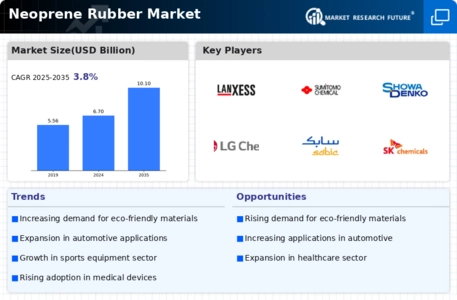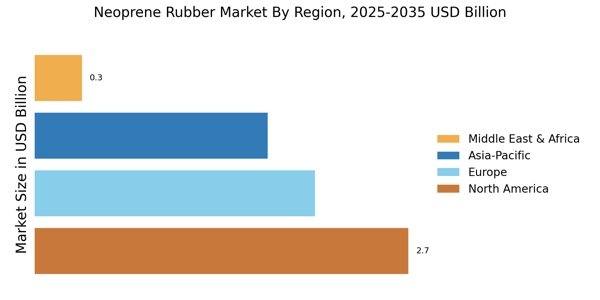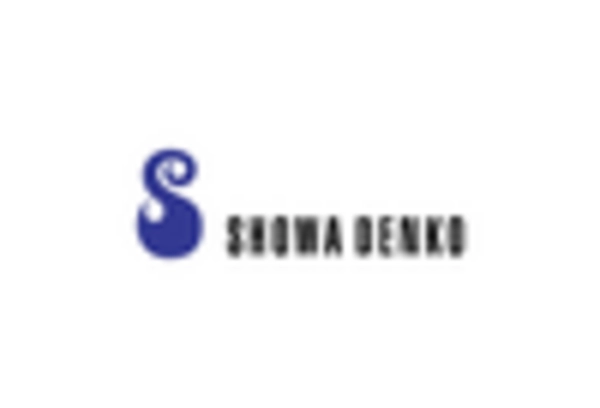Expansion in Consumer Goods
The Neoprene Rubber Market is witnessing an expansion in the consumer goods sector, particularly in the production of sports and leisure products. Neoprene's unique properties, such as flexibility, durability, and resistance to water, make it an ideal material for items like wetsuits, bags, and protective gear. The market for neoprene in consumer goods is projected to grow at a compound annual growth rate of around 6% through 2025. This growth is attributed to the increasing popularity of outdoor activities and sports, which drives demand for high-performance gear. Additionally, the rise of eco-friendly products is influencing manufacturers to adopt neoprene rubber, as it can be produced with sustainable practices. As a result, the neoprene rubber market is likely to see a significant uptick in applications within the consumer goods sector.
Rising Demand in Automotive Sector
The Neoprene Rubber Market experiences a notable surge in demand from the automotive sector. As manufacturers increasingly prioritize lightweight and durable materials, neoprene rubber emerges as a preferred choice for various applications, including seals, gaskets, and insulation. The automotive industry is projected to account for a significant share of the neoprene rubber market, driven by the need for enhanced fuel efficiency and reduced emissions. In 2025, the automotive sector's demand for neoprene rubber is expected to grow by approximately 5% annually, reflecting a broader trend towards sustainable materials. This growth is likely to be fueled by the increasing production of electric vehicles, which require advanced materials for battery insulation and thermal management. Consequently, the neoprene rubber market is poised to benefit from these evolving automotive trends.
Growth in Construction and Infrastructure
The Neoprene Rubber Market is experiencing growth driven by the construction and infrastructure sectors. Neoprene rubber is increasingly utilized in construction applications, such as expansion joints, seals, and vibration dampening materials. The global construction industry is projected to grow at a rate of 4% annually, which directly influences the demand for neoprene rubber. As urbanization continues to rise, the need for durable and resilient materials in infrastructure projects becomes paramount. Neoprene's resistance to weathering and chemical exposure makes it a suitable choice for various construction applications. By 2025, the neoprene rubber market is expected to see a substantial increase in demand from the construction sector, reflecting the ongoing investments in infrastructure development.
Technological Innovations in Manufacturing
Technological innovations in manufacturing processes are significantly impacting the Neoprene Rubber Market. Advances in production techniques, such as improved polymerization methods and enhanced mixing technologies, are leading to higher quality neoprene products with better performance characteristics. These innovations not only increase efficiency but also reduce production costs, making neoprene rubber more accessible to various industries. In 2025, the market is expected to benefit from these advancements, with a projected increase in production capacity by approximately 7%. Furthermore, the integration of automation and smart manufacturing practices is likely to streamline operations, allowing manufacturers to respond more swiftly to market demands. This technological evolution is essential for maintaining competitiveness in the neoprene rubber market.
Increased Focus on Environmental Regulations
The Neoprene Rubber Market is influenced by an increased focus on environmental regulations and sustainability initiatives. As governments worldwide implement stricter regulations regarding material usage and waste management, manufacturers are compelled to adopt eco-friendly practices. Neoprene rubber, known for its durability and recyclability, aligns well with these sustainability goals. The market is likely to see a shift towards greener production methods, which could enhance the appeal of neoprene rubber in various applications. By 2025, the demand for environmentally compliant neoprene products is expected to rise, potentially increasing market share by 10%. This trend indicates a growing awareness among consumers and industries regarding the importance of sustainable materials, further driving the neoprene rubber market.


















Leave a Comment